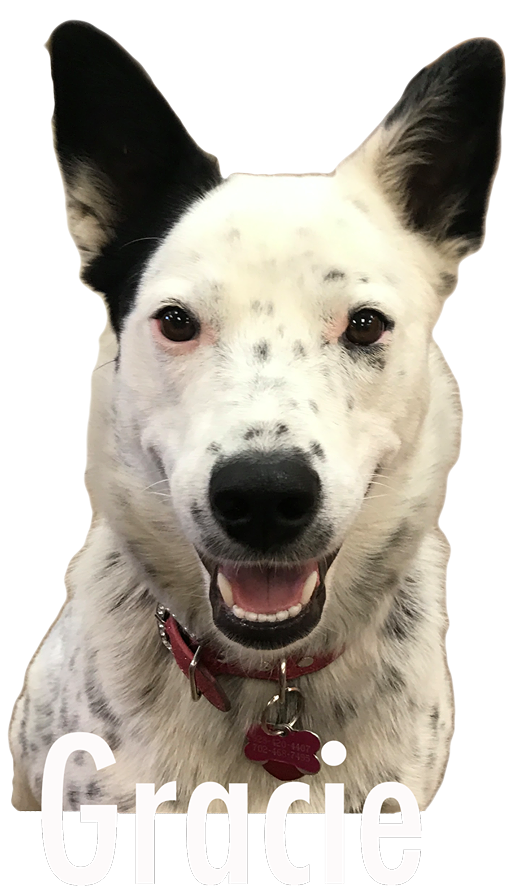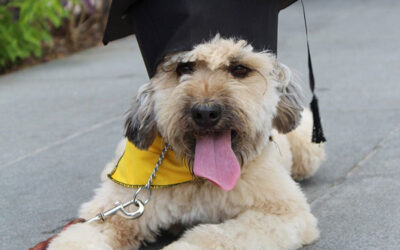Photos and testimonials courtesy of Soldier’s Best Friend except where noted
To recap: SBF’s mission is to help vets with PTSD and traumatic brain injury (TBI) live happier, healthier lives by pairing them with service dogs, a highly successful therapeutic approach not yet widely adopted federally. Their secondary mission is to address the crisis of homeless pets by training dogs rescued from shelters. Though they will train dogs brought in by vets, the difficulty of transitioning from family pet to serious working dog reduces successful outcomes. The shelter dogs are fostered for 4-6 weeks to allow for observation and early identification of behavioral issues or physical problems like hip dysplasia. 90% of SBF dogs successfully complete the program.
Executive Director Mik Milem attributes their high success rate partly to their unique vet-dog training approach. Most shelter-to-service programs pre-train their dogs, providing veteran applicants with 4-8 weeks of bonding and task-learning once paired. SBF’s methodology calls for vets to train their newly paired dogs themselves, alongside a qualified trainer — a process that takes from 6-9 months. This deepens the human-animal bond and increases confidence for transitioning from the program to everyday life. All training and veterinary care during the process is provided at no initial cost to veterans. Applicants are accepted from anywhere in the U.S., but they must temporarily relocate to Arizona, and are responsible for the cost of travel and accommodations for the duration of training.
The three biggest challenges facing SBF right now are 1) Insufficient training staff: All SBF trainers are part-time volunteers with full-time jobs elsewhere, so it’s a challenge to offer enough training time. 2) The constant need for foster families to house dogs during the observation period. 3) Lack of consistent standards and criteria for service dogs, especially those for psychiatric issues — they are a relatively recent category. The American Disabilities Act (ADA) has yet to be updated to provide explicit guidelines for training. The last revision to the ADA’s Service Animal Requirements section was in 2010. Though it was updated to include PTSD as a qualifying medical condition and to differentiate between service dogs (considered working dogs not pets) and emotional support or assistance animals, there is no formal certification process.
Standards and training criteria are enormously important to accessibility for veterans with mental health issues, to ensure both the reliability of service dog behavior as well as acceptance and cooperation from the community at large. As it stands, training styles differ drastically in timing and effectiveness, from 2 weeks to 9 months – a quick online search even yields ads promising to certify service dogs in 5 minutes! Also, anyone can buy a service dog vest on the Internet and place it on their dog. There’s no formal way to distinguish a pet in a vest from a legitimately trained working dog, and business staff can only ask limited questions to patrons: 1) Is the animal necessary due to a disability? and 2) What work/tasks has the dog been trained to perform? Businesses cannot require any certification/training credentials. The lack of standards has negative consequences for those with legit working dogs. For instance, Nic reports encountering misbehaved dogs in uniform while in a store with Bennett. Such dogs may create noise disturbances, show unwanted attention to customers, or worse, show aggression to vets and their actual service dogs, risking physical or mental trauma. With no formal guidelines, store staff are likely to ask that both dogs be removed.
Under the Puppies Assisting Wounded Servicemembers for Veterans Therapy Act (PAWS) signed into law by President Biden in 2021 the VA was granted funding for a pilot study of service dogs for PTSD/TBI, but implementation has been slow to nonexistent, and was only authorized for 5 participating providers in the US, none in Arizona. Meanwhile, the nonprofit coalition Association of Service Dog Providers for Military Veterans is raising awareness and promoting wider use of service dogs for vets by creating certification standards. To join the coalition nonprofits must apply for membership, a costly, 2-year process that smaller organizations find challenging. SBF is nearly a year into their certification process.
Until there is better federal funding for this proven program for vets with PTSD, these grassroots outfits rely on concerned citizens to operate. Organizations like Soldier’s Best Friend are a life-saving gift, helping to prevent veteran suicides and homeless dog euthanasia thanks to the care and generosity of supportive people.
Find out how you can help at https://soldiersbestfriend.













